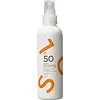What's inside
What's inside
 Key Ingredients
Key Ingredients

 Benefits
Benefits

 Concerns
Concerns

No concerns
 Ingredients Side-by-side
Ingredients Side-by-side

Water
Skin ConditioningOctocrylene
UV AbsorberButane
Butyl Methoxydibenzoylmethane
UV AbsorberDiethylamino Hydroxybenzoyl Hexyl Benzoate
UV FilterPropylene Glycol
HumectantEthylhexyl Isononanoate
EmollientStearic Acid
CleansingPalmitic Acid
EmollientVp/Hexadecene Copolymer
Isobutane
Bis-Ethylhexyloxyphenol Methoxyphenyl Triazine
Skin ConditioningDipropylene Glycol
HumectantPvp
Emulsion StabilisingEthylhexyl Triazone
UV AbsorberPropane
Polysorbate 20
EmulsifyingTriethanolamine
BufferingBis(Cyano Butylacetate) Anthracenediylidene
Skin ConditioningSodium Palmitoyl Proline
Skin ConditioningButylene Glycol Dicaprylate/Dicaprate
EmollientSilica
AbrasiveNymphaea Alba Flower Extract
Skin ConditioningSodium Ascorbyl Phosphate
AntioxidantC12-15 Alkyl Benzoate
AntimicrobialTocopheryl Acetate
AntioxidantGlycerin
HumectantButylene Glycol
HumectantDimethicone
EmollientTetrasodium Glutamate Diacetate
Water, Octocrylene, Butane, Butyl Methoxydibenzoylmethane, Diethylamino Hydroxybenzoyl Hexyl Benzoate, Propylene Glycol, Ethylhexyl Isononanoate, Stearic Acid, Palmitic Acid, Vp/Hexadecene Copolymer, Isobutane, Bis-Ethylhexyloxyphenol Methoxyphenyl Triazine, Dipropylene Glycol, Pvp, Ethylhexyl Triazone, Propane, Polysorbate 20, Triethanolamine, Bis(Cyano Butylacetate) Anthracenediylidene, Sodium Palmitoyl Proline, Butylene Glycol Dicaprylate/Dicaprate, Silica, Nymphaea Alba Flower Extract, Sodium Ascorbyl Phosphate, C12-15 Alkyl Benzoate, Tocopheryl Acetate, Glycerin, Butylene Glycol, Dimethicone, Tetrasodium Glutamate Diacetate
Water
Skin ConditioningAloe Barbadensis Leaf Extract
EmollientDibutyl Adipate
EmollientDiethylamino Hydroxybenzoyl Hexyl Benzoate
UV FilterC12-15 Alkyl Benzoate
AntimicrobialEthylhexyl Triazone
UV AbsorberBis-Ethylhexyloxyphenol Methoxyphenyl Triazine
Skin ConditioningDiethylhexyl Butamido Triazone
UV AbsorberGlycerin
HumectantHydrogenated Dimer Dilinoleyl/Dimethylcarbonate Copolymer
Emulsion StabilisingMicrocrystalline Cellulose
AbsorbentAcrylates/C12-22 Alkyl Methacrylate Copolymer
Disodium Cetearyl Sulfosuccinate
CleansingSodium Levulinate
Skin ConditioningCellulose Gum
Emulsion StabilisingTocopherol
AntioxidantArginine
MaskingPolyglyceryl-2 Dipolyhydroxystearate
Skin ConditioningLauryl Glucoside
CleansingCoco-Glucoside
CleansingXanthan Gum
EmulsifyingDisodium Lauryl Sulfosuccinate
CleansingCitric Acid
BufferingSorbic Acid
PreservativePhenoxyethanol
PreservativePotassium Sorbate
PreservativeWater, Aloe Barbadensis Leaf Extract, Dibutyl Adipate, Diethylamino Hydroxybenzoyl Hexyl Benzoate, C12-15 Alkyl Benzoate, Ethylhexyl Triazone, Bis-Ethylhexyloxyphenol Methoxyphenyl Triazine, Diethylhexyl Butamido Triazone, Glycerin, Hydrogenated Dimer Dilinoleyl/Dimethylcarbonate Copolymer, Microcrystalline Cellulose, Acrylates/C12-22 Alkyl Methacrylate Copolymer, Disodium Cetearyl Sulfosuccinate, Sodium Levulinate, Cellulose Gum, Tocopherol, Arginine, Polyglyceryl-2 Dipolyhydroxystearate, Lauryl Glucoside, Coco-Glucoside, Xanthan Gum, Disodium Lauryl Sulfosuccinate, Citric Acid, Sorbic Acid, Phenoxyethanol, Potassium Sorbate
Ingredients Explained
These ingredients are found in both products.
Ingredients higher up in an ingredient list are typically present in a larger amount.
You might know this ingredient as Tinosorb S or Bemotrizinol. It is a UV filter that covers both UVA and UVB rays.
This ingredient has two peak UV absorption peaks ( 310 and 340 nm) and is able to absorb both UV-A and UV-B rays. This ingredient works by preventing UV rays from reaching and damaging your skin.
On top of that - it is highly photostable and helps prevent the photodegration of other sunscreen ingredients such as avobenzone.
Tinosorb S is allowed in the EU, Australia, and Asia. It is close to being approved by the FDA and we'll hopefully get this ingredient in the U.S. by late 2025.
Fun fact: Tinosorb S is the most effective UV absorber at maximum concentration (measured by SPF) permitted in the EU.
This ingredient is oil-soluble, so your oil-cleansers will take this right off at night.
Learn more about Bis-Ethylhexyloxyphenol Methoxyphenyl TriazineC12-15 Alkyl Benzoate is made up of Benzoic Acid and long chain alcohols. It has a low molecular weight.
C12-15 Alkyl Benzoate is an emollient and texture enhancer. Due to its solubility, it is often used in sunscreens to help evenly distribute active ingredients.
As an emollient, C12-15 Alkyl Benzoate helps soften and hydrate your skin. Emollients create a film on your skin that traps moisture within.
This ingredient has been reported to cause eye irritation.
Learn more about C12-15 Alkyl BenzoateDiethylamino Hydroxybenzoyl Hexyl Benzoate (DHHB) is a chemical UV-A absorber. It is formulated for high UVA protection (320-400 nm).
DHHB is well-liked for:
DHHB has been approved by the EU, Japan, Taiwan, and South America for use up to 10%. Unfortunately, it has not been approved for use in the US or Canada due to slow regulatory processes.
This ingredient is soluble in oils, fats, and lipids.
Learn more about Diethylamino Hydroxybenzoyl Hexyl BenzoateEthylhexyl Triazone is a modern chemical sunscreen that protects from UV-B radiation.
It is the most effective of existing UV-B filters, as it provides the highest level of photo-stable absorption. It protects from the entire UV-B range (280 to 320nm), with it's highest level of protection at 314nm.
Ethylhexyl Triazone is oil soluble, oderless and colorless, which mean it is able to be incorporated into a variety of different formulations.
It is not currently available within the United States due to slow changing FDA regulations. Outside of the US, it is used in formulations at concentrations up to 5%.
Learn more about Ethylhexyl TriazoneGlycerin is already naturally found in your skin. It helps moisturize and protect your skin.
A study from 2016 found glycerin to be more effective as a humectant than AHAs and hyaluronic acid.
As a humectant, it helps the skin stay hydrated by pulling moisture to your skin. The low molecular weight of glycerin allows it to pull moisture into the deeper layers of your skin.
Hydrated skin improves your skin barrier; Your skin barrier helps protect against irritants and bacteria.
Glycerin has also been found to have antimicrobial and antiviral properties. Due to these properties, glycerin is often used in wound and burn treatments.
In cosmetics, glycerin is usually derived from plants such as soybean or palm. However, it can also be sourced from animals, such as tallow or animal fat.
This ingredient is organic, colorless, odorless, and non-toxic.
Glycerin is the name for this ingredient in American English. British English uses Glycerol/Glycerine.
Learn more about GlycerinWater. It's the most common cosmetic ingredient of all. You'll usually see it at the top of ingredient lists, meaning that it makes up the largest part of the product.
So why is it so popular? Water most often acts as a solvent - this means that it helps dissolve other ingredients into the formulation.
You'll also recognize water as that liquid we all need to stay alive. If you see this, drink a glass of water. Stay hydrated!
Learn more about Water